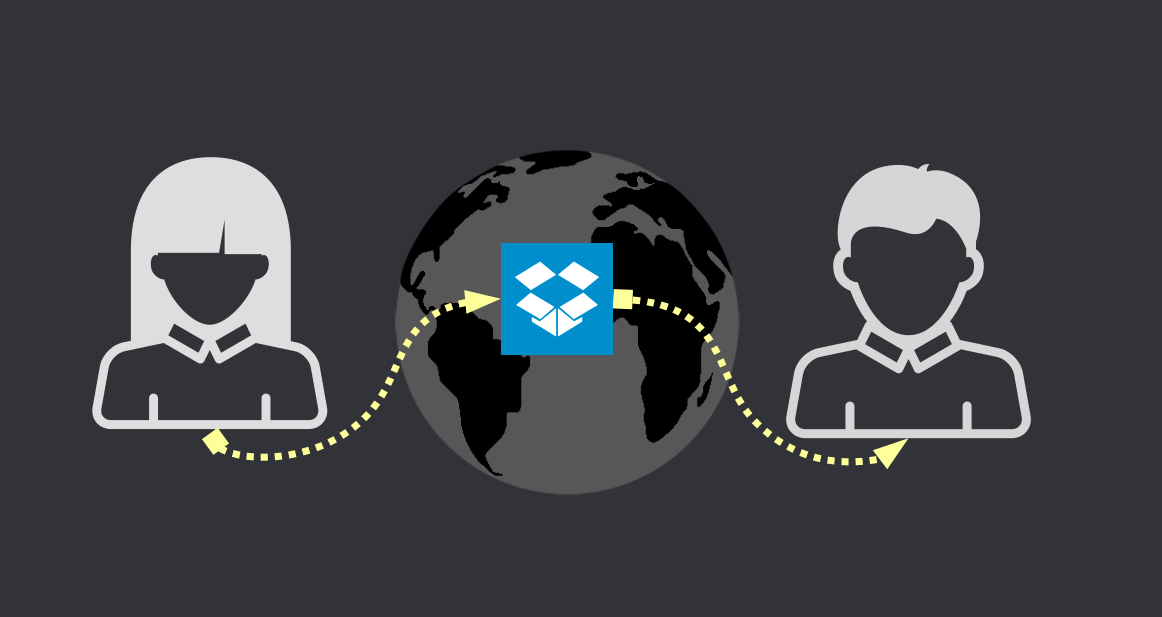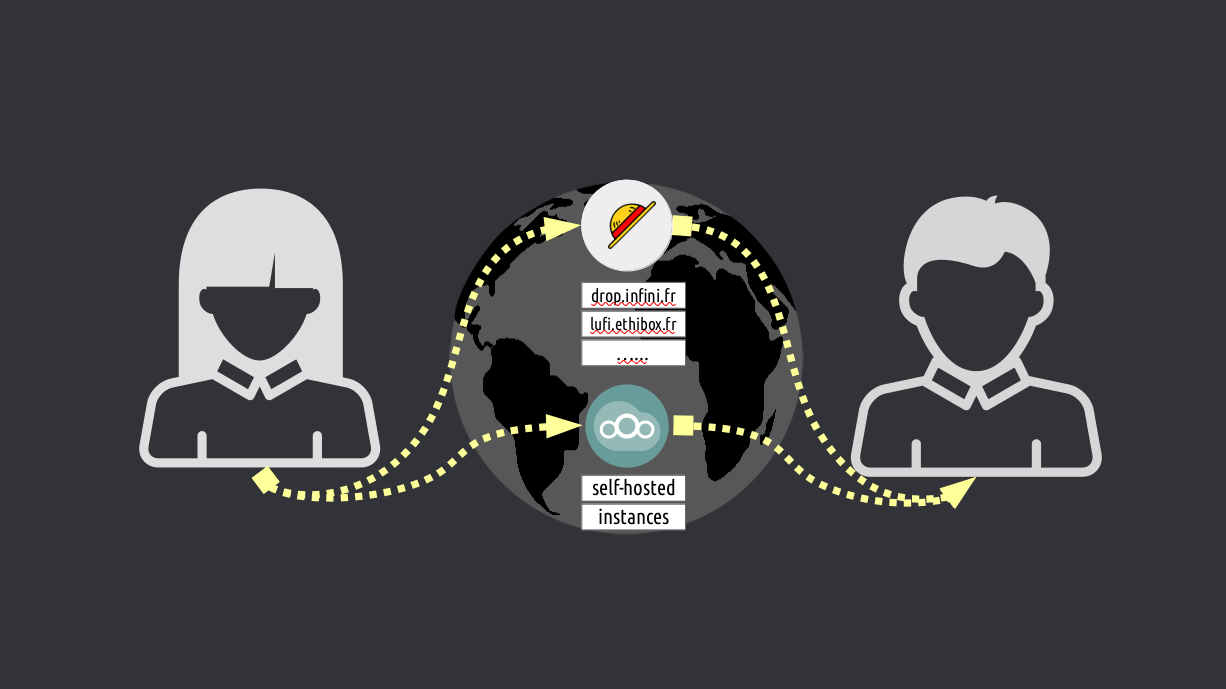share files trade-free
Images, videos, audio files, text….applications, archives….how can we share files in the digital universe? Popular services such as Dropbox, Google Drive, or iCloud seem to be the “way to go” for the task. However, they ask you for many trades such as currency trade (like money), data, attention (ads and promotions), or artificial limitations in order for you to subscribe for their “pro” or “premium” accounts. You have to trade a lot with them, give them your currency, data, attention, privacy, or register with them in order to use their services.
Here’s Ana and Bubu again. They want to share files with each other. Their photos and videos, or a lot more than that. That’s all they want and the world stays between them. How can they do it?

If they would use one of those popular file sharing platforms, then Ana would have to register with one of them and trade a lot to that company, and after they approve her, Ana can upload the files to that company’s servers via the browser or a desktop/mobile app. She can, at times depending on the service, share the files with Bubu via a custom link that she has to send him via email or any other methods. Sometimes it is required that Bubu should have an account with the same company in order to get the files. This is how most people share the files. Ana goes through a multi-step process to register and trade with a company, to then upload the photos manually to their servers or download and install their desktop application, and then use a 3rd party method such as email to send a link to Bubu. Bubu may need the same desktop application or at times only a browser to receive the files (download or sync them).

On top of the many trades that they are forced to do, their files are controlled 100% by a company. If the company decides that the files are not “ok” (illegal or whatever they may call them), then the company will remove the files. The company can also see Ana’s nude photos if they want to, or Bubu’s love poems that he sends to Ana as text documents. Their file sharing is crippled with trades and completely slave to the company’s rules and “morals”. Other companies such as WeTransfer pretend to be free by letting users upload files up to X GB to their servers and share the uploads with others without users paying any money or registering an account with them. However, as you may understand by now, these are not trade-free since they are often full of ads and data mining techniques.
So, then, how can Ana share large amounts of files (perhaps unlimited) with Bubu in a trade-free way?
In essence there are two main ways one can share files online. First, the classic “upload to a server” style. And this server acts as storage system. It stores the files and the other persons can access them any time. The advantages of such a system is that the files are always available. The biggest downside is that centralizing file sharing comes with a huge responsibility and you never know who is behind these servers or what they do with your files. Also, most such services are limited in terms of storage space.

The second way is the “nodes” way. Multiple servers or people’s computers make the connection with each other, and when Ana shares something the nodes only connect her with Bubu, to then allow for a direct transfer of files between the two. The nodes should not be able to read/access any files that the two are sending.

LEVEL 1: HONEST WETRANSFER
One simple solution is a sort of WeTransfer that is trade-free. Lufi is one such alternative. An open source piece of software that anyone can install on their own server and create a trade-free WeTransfer. Here are some Lufi instances that simply let you upload files and then copy the URL and share it with anyone you want. No bullshit. No ads. No data mining. And encrypted, so that no such instance can read what you are uploading. A more complex but full-featured solution is NextCloud. This one allows for a great control over files (from versioning to backups or automated sync). However, unless Ana really knows how to install and run NextCloud on her own computer and transform her computer into a network, then Ana is at the mercy of other servers (like in the case of Lufi) that may provide a trade-free (and limited) NextCloud instances. This can be very rare to find since NextCloud is more than a simple file-sharing and hosting service, so it requires a lot of server power. Even the instances that provide a “free” NextCloud instance, often charge for more storage or “premium” features, so they are not really trade-free. In essence, yes, there are honest WeTransfer services that allow you to share files trade-free. But they are limited in terms of storage space.

LEVEL 2: DECENTRALIZED DROPBOX
The best way to share an unlimited amount of files is to directly transfer files from one to another. Nodes do just that, by finding a bridge between Ana and Bubu. So when Ana sends a file to Bubu, the nodes connect the two. The biggest downside is that both Ana and Bubu have to be online for the files to transfer. But since we are pretty much always connected to the internet these days, maybe this is not a huge disadvantage. Considering that no one can delete any of the files you are sharing, this method is by far the most convenient. Think of this method as an offline package delivery service (like the postal service). Ana sends a package to Bubu, and the postal office or the package delivery service is simply getting the package from Ana to Bubu without opening it. That’s how it should be done. Not like Google Driver or Dropbox are doing it, by opening the package and removing any content that they deem as “wrong”. The best part of this Level 2 file-sharing is that the package delivering service doesn’t even know the size of the packages many times, or who Ana or Bubu are.

So, when it comes to file sharing the reliance on servers (centralized means) is going to be limited in terms of how many files you can share or what kinds of, even when we are talking about trade-free services. The best approach is to directly connect Ana and Bubu, not through one point, but multiple (as nodes). This way Ana can send as many nude photos and astronomy photos and videos to Bubu as she wants, and no one would be able to either sniff them or limit how many she can send.
Trade Free alternatives
Bellow we will recommend some trade-free apps for TROMjaro that allow Ana and Bubu to share files with each other. We will emphasize 4 core features for each of them:
EASE OF USE
PRIVATE
RELIABLE
DYNAMIC
Syncthing is perhaps the best file-sharing application. Very easy to use, since all you have to do is to share your ID with your friend, then you are connected. The next simple step is to add a folder to your sharing list, and then share this folder with your friend. Say you create a new folder on your computer and name it “Bubu”. Add it to Syncthing and share it with your friend. Whatever you add to the “Bubu” folder will automatically be shared with your friend and copied to his/her computer. As simple as that. On top of it Syncthing can keep versions of the files, so in case you delete or change any, it will keep a backup of that.
Syncthing comes pre-installed on TROMjaro because it is very easy to use, it is private (the connections to the nodes are encrypted), it is highly reliable and very dynamic since it automatically syncs all changes to any files. It can even be used for backups. The only downside of Syncthing is that it does not support “public shares” – like sharing a “link” or something with multiple people as public. People need to connect to you one by one, in order for you to share files with them. Thus, Syncthing is geared towards private file sharing.
Amule is an application that lets you access the ED2K network. It is geared towards file sharing, channels and chats, and more. So the “ease of use” is not that great if all you want is to share some files with your friends. You can however share files publicly with anyone on the ED2K network or with anyone that has a client for the network. It can be as easy as sharing a “link” with your friend and him/her opening it with Amule. The reliability is not that great and we do not know if the connection between the nodes (servers) is encrypted. But you can share as many files and folders as you want with Amule and on top of that it will keep an eye on the changes made to these folders and update them automatically (thus, it is dynamic).
Transmission is a BitTorrent client. One of the most reliable networks out there. In order to share files with Transmission you have to create a “torrent” file from a file or folder. So say you want to share a folder with Ana, you add the folder to Transmission and then you have to manually add “trackers” (nodes) to the list. If you are not familiar with this then you will find it very difficult as this is the main thing that you have to do in order for your folder to be “discovered” by Ana. If you manage to do this, it is very easy to share the folder either via a link (magnet) or via a file (torrent), both act as a tunnel between you two. Ana can very easily copy the link you give to her, to Transmission and the download will start.
Transmission, like all BitTorrent clients, is not dynamic. If you share a folder then that’s all you share. Any changes to the folder won’t be pushed to Ana. You will have to repeat the process with every change. Transmission is geared towards one-time-share. If you want to publicly share a non-dynamic folder with the world, BitTorrent is the best way to do it, and Transmission is a very easy to use client if you understand what trackers are and how to add them.
WebTorrent is another BitTorrent client, but this one is perhaps the easiest to use of them all. Again, it does not support dynamic folders and we do not know if the connections to the nodes are encrypted, but to share a folder/file is as easy as clicking “Share Folder” or “Share File”. WebTorrent adds the BitTorrent trackers on its own so all you have to do is to share the magnet link or the torrent file with your friend(s).
The DAT Network is a new and very interesting network. It allows for people to connect with others in a decentralized way. Since it is still new, it is not very reliable and connections are not always established. But when it works, the DAT desktop makes it extremely easy to share and receive files, as that’s the sole purpose of this app. It encrypts the connections between peers and it supports dynamic folders.
So, choose a folder to share with Ana and then send her the unique DAT url so that she can receive it with the DAT Desktop. And any changes you make to that folder, will be automatically pushed to Ana’s computer. As easy as that!
BiglyBT is another BitTorrent client, but it is more complicated to use. However it offers more options. No dynamic folders, but secure and reliable. If Ana wants to use BiglyBT to share files in a more complex manner (with specific rules and such), then BiglyBT can be a good tool for that. Else, Ana is better off sharing files using other apps.
RetroShare is a lot more than a file sharing application. In fact it is not meant for that, it is meant for email, chats, forums, and also file sharing. So, for the average user this may be a bit difficult to navigate if the only thing they need is to share files. It supports dynamic folders though, which is a big plus when you want to share files that you may change, or add/remove files after you have shared a folder.
RetroShare is not that reliable in establishing connections between peers so be aware of that. The fantastic part of RetroShare is that it does not rely on any well-known network. It is its own thing and it is properly-decentralized.
Beaker uses the DAT Network and similar to the DAT Desktop app, it provides all of the features such as dynamic folders and encryption. It is not as easy to use as DAT Desktop because Beaker is more than a file sharing app, so it may take a bit of time to understand how to use it. However one cool thing about Beaker is that you can preview the files in Beaker directly, without downloading them. So say you share 30 videos with Bubu. Send to Bubu the Beaker (DAT) URL and Bubu can simply open that in Beaker and play any video he wants without downloading them. Beaker allows for the perfect combination of sharing something privately or publicly, and to easily access both.
Imagine you have 5.000 photos that you want to share with the world. You simply point Beaker to the folder where you have the photos stored, and then share the DAT URL with the world. Anyone with the link can view your photos with Beaker without downloading them to their computers. And, if you add or remove photos, then you don’t have to do anything, the same URL will work to display the new changes. Of course, is worth mentioning again that the DAT Network is not 100% reliable so at times the connection between users cannot be established.
OnionShare uses the well-known TOR network for file sharing, which is damn cool. Sharing files is thus, extremely private and quite reliable. To use it, is as simple as sharing or downloading a file/folder. You choose a folder, then wait for it to be “scanned” which can take a long time if there are many files in that folder, and once it is done you can share the generated link to anyone who uses the TOR Browser. Similar to the Beaker app, files can be previewed in the browser without being downloaded.
But, it does not support dynamic folders and Bubu needs to also install the TOR Browser to get Ana’s files. Also, the download speeds may be very slow over the TOR Network. But hey, it is yet another trade-free way to share unlimited amounts of files with anyone!
This article will be updated from time to time to add new apps to the list.
SIMILAR APPS:
no related apps.

